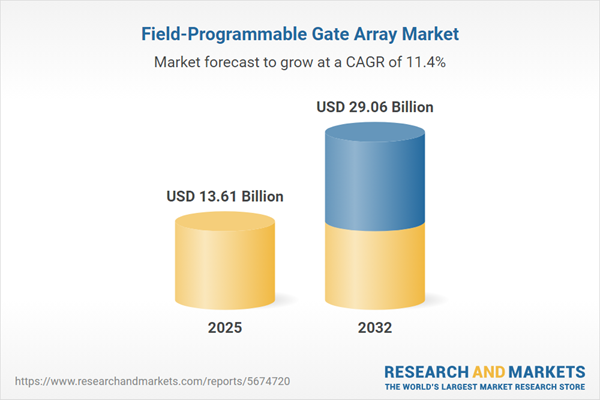Speak directly to the analyst to clarify any post sales queries you may have.
The field-programmable gate array (FPGA) market is experiencing rapid evolution, fueled by technological convergence and mounting demand for tailored electronic solutions. As organizations prioritize agility and advanced performance, FPGAs are cementing their strategic role across high-impact industries.
Market Snapshot: Growth and Transformation in the FPGA Market
The field-programmable gate array market grew from USD 12.27 billion in 2024 to USD 13.61 billion in 2025. It is forecast to maintain a compound annual growth rate (CAGR) of 11.37%, reaching a value of USD 29.06 billion by 2032. This expansion highlights FPGAs’ increasing relevance as industries adapt to demands for configurable hardware in next-generation applications.
Scope & Segmentation: Defining the FPGA Market Landscape
This report dissects the FPGA sector by analyzing several dimensions critical to strategic planning and technology adoption:
- Configuration Types: Anti-fuse, Flash, Static RAM
- Node Sizes: 28-90 nm FPGAs, Greater Than 90 nm FPGAs, Less Than 28 nm FPGAs
- Technologies: Hybrid Memory Cube, Neuromorphic Computing, System on Chip (SoC) Integration
- Architectures: High-end FPGA, Low-end FPGA
- Processor Types: Digital Signal Processors, General Purpose Processors, Microcontrollers, Programmable Application-Specific
- Applications: Aerospace & Defense (Military Communication Systems, Unmanned Aerial Vehicles), Automotive (Advanced Driver Assistance Systems, Infotainment Systems), Communication (Data Centers, Telecommunication Systems), Consumer Electronics (Smartphones, Tablets, Wearable Devices), Healthcare (Biometrics Monitoring, Medical Imaging), Industrial (Factory Automation, Industrial IoT)
- Regions: Americas (United States, Canada, Mexico, Brazil, Argentina, Chile, Colombia, Peru), Europe, Middle East & Africa (United Kingdom, Germany, France, Russia, Italy, Spain, Netherlands, Sweden, Poland, Switzerland, United Arab Emirates, Saudi Arabia, Qatar, Turkey, Israel, South Africa, Nigeria, Egypt, Kenya), Asia-Pacific (China, India, Japan, Australia, South Korea, Indonesia, Thailand, Malaysia, Singapore, Taiwan)
- Companies Analyzed: Achronix Semiconductor Corporation, Acromag Inc., Advanced Micro Devices Inc., Efinix Inc., Flex Logix Technologies Inc., GOWIN Semiconductor Corporation, Infineon Technologies AG, Intel Corporation, Lattice Semiconductor Corporation, Menta S.A.S, Microchip Technology Inc., National Instruments Corporation, QuickLogic Corporation, Renesas Electronics Corporation, Texas Instruments Incorporated
Key Takeaways: Strategic Insights for Senior Decision-Makers
- FPGAs’ ability to support real-time hardware reconfiguration is fundamental for sectors navigating AI, edge computing, and 5G deployment.
- Adoption is rising across diverse industries, from aerospace systems requiring reliability to automotive platforms that demand low-latency response.
- Hardened intellectual property and hybrid computing architectures drive the integration of FPGAs in both cloud and on-premises environments.
- System-level security—including encryption and anti-tamper features—is a growing selection criterion, especially within defense and data-sensitive sectors.
- Regional market dynamics, such as manufacturing leadership in Asia-Pacific and compliance priorities in Europe, are shaping competitive strategies worldwide.
- Vendor ecosystems—particularly those involving EDA tool development and cloud service alliances—are reducing barriers to design and accelerating time-to-market.
Tariff Impact: Navigating Trade and Policy Shifts
Recent adjustments to United States tariff schedules have placed cost pressures on OEMs sourcing advanced semiconductor components, including FPGAs. These measures have prompted shifts in sourcing strategies, with some firms opting for suppliers in tariff-neutral regions and others investing in onshore assembly to manage supply chain risk. Design philosophies are also adapting, as organizations focus on regionalizing production for critical workloads with high latency or security requirements.
Methodology & Data Sources
The insights in this report stem from structured interviews with FPGA architects, integrators, and industry executives, supplemented by surveys targeting procurement and engineering teams. Secondary research encompasses technical publications, industry white papers, financial filings, patent reviews, and regulatory materials. Multiple data inputs were triangulated to ensure credible, actionable intelligence.
Why This Report Matters
- Senior leaders gain a comprehensive view of FPGA technology adoption, configuration options, and regional trends to inform strategic decisions.
- Insights on supply chain risk, regulatory impacts, and emerging technology integration support effective planning and future-proofing.
Conclusion
The field-programmable gate array market is set for continual transformation as technological, regulatory, and competitive factors intersect. Stakeholders equipped with detailed insight will be best positioned to drive innovation and create sustainable value in this expanding sector.
Additional Product Information:
- Purchase of this report includes 1 year online access with quarterly updates.
- This report can be updated on request. Please contact our Customer Experience team using the Ask a Question widget on our website.
Table of Contents
3. Executive Summary
4. Market Overview
7. Cumulative Impact of Artificial Intelligence 2025
Companies Mentioned
The companies profiled in this Field-Programmable Gate Array market report include:- Achronix Semiconductor Corporation
- Acromag‚ Inc.
- Advanced Micro Devices, Inc.
- Efinix Inc.
- Flex Logix Technologies, Inc.
- GOWIN Semiconductor Corporation
- Infineon Technologies AG
- Intel Corporation
- Lattice Semiconductor Corporation
- Menta S.A.S
- Microchip Technology Inc.
- National Instruments Corporation
- QuickLogic Corporation
- Renesas Electronics Corporation
- Texas Instruments Incorporated
Table Information
| Report Attribute | Details |
|---|---|
| No. of Pages | 188 |
| Published | November 2025 |
| Forecast Period | 2025 - 2032 |
| Estimated Market Value ( USD | $ 13.61 Billion |
| Forecasted Market Value ( USD | $ 29.06 Billion |
| Compound Annual Growth Rate | 11.3% |
| Regions Covered | Global |
| No. of Companies Mentioned | 16 |









